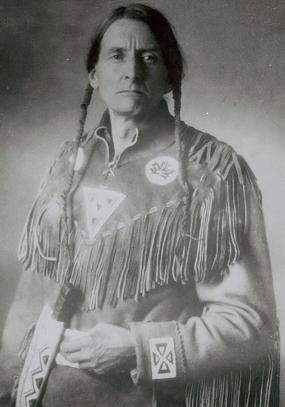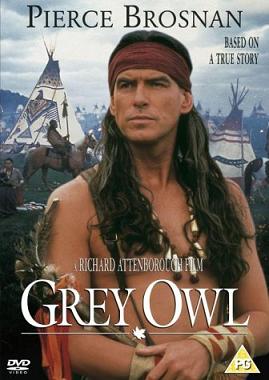

| Home Contents Contact |
|
|

Amongst the broad variety of stereotypical perceptions spawned by more than half a millennium of intercultural contact, one which has its seeds in ancient times but has expanded in direct proportion with the strain of civilization, is that of the Native American as an instinctive conservationist, the ecological doorkeeper of mankind. One man who has more to do with this development than any other is Grey Owl, who emerged from the obscurity of the Canadian wilderness during the inter-war years. A former fur trapper, he was converted to the ways of compassion by his part-Iroquois wife, Gertrude Barnard, whom he called by the more romantic appellation of Anahareo.
Grey Owl entered the service of the Canadian government as a naturalist, at the wild life sanctuary in Prince Albert National Park. Brought back from the verge of oblivion, the Canadian wilderness flourished in this magical place once more, as it had done before the coming of the white man.
Discovering a prodigious literary talent, Grey Owl set about preaching the then emerging gospel of conservation from his solitary log cabin at the edge of Ajawaan Lake, located at the northern end of Kingsmere Lake in Saskatchewan. With what degree of sincerity will probably never be known, he also became an early champion of animal rights. He defended the use of animals for self-sustenance but abhorred killing for its own sake and denounced blood sports as anathema.
During the late 1800s, the near obliteration of the beaver and the buffalo might have seemed to some like the crowning achievements in the progress of civilization but with the cataclysmic 20th century well underway, there were those who, trapped in the industrial wasteland, were not so sure.
Grey Owl’s skin colour was somewhat lighter than might have been expected and his eyes were blue but these personal anomalies were readily accounted for by the fact that he never claimed to be a full-blooded Indian. His father, he alleged, had been a Scotsman, a descendent of the McNeills of Barra and was, moreover, in some way connected to Buffalo Bill Cody. Grey Owl even recounted on occasion that he himself had first come to the UK as a knife-throwing act with Buffalo Bill. The most puzzling of the mysteries surrounding this enigmatic character is his habitual repertoire of Lakota phrases. His mother, he said, had been a full-blooded Jicarilla Apache; he had been associated with the Ojibway of Bear Island, Ontario, among whom, in 1910, he found his first wife; the subsequent marriage, performed by a Cree chief in Northern Quebec, was contracted in 1926 with a lady of Iroquois heritage. At exactly which point in his obviously extensive peregrinations had he been a Lakota speaker? Perhaps during his time with Buffalo Bill? This particular yarn would superficially appear the most plausible explanation.
Publications and lecture tours followed; he came to Scotland twice, in 1935-36 and 1937. For a time at least, he was something of an international celebrity. Always a man of striking appearance, with a natural penchant for theatre, he invariably held his audiences spellbound as he stood before them in traditional Native American garb. The Glasgow Herald, 25th November 1935, proclaimed him ‘The Modern Hiawatha’.
The Scottish venues on his UK tours were the following:
1935-36 28th November 1935 Glasgow McLellan Galleries 29th - 30th November 1935 Edinburgh Music Hall 11th January 1936 Helensburgh Victoria Hall 13th January 1936 Ayr Carnegie Library 14th January 1936 Edinburgh Usher Hall
1937 19th November 1937 Dundee Caird Hall 20th November 1937 Helensburgh Victoria Hall 22nd November 1937 Paisley Paisley Town Hall 23rd - 24th November 1937 Glasgow Lyric Theatre 26th November 1936 Edinburgh Music Hall 27th November 1936 Edinburgh Usher Hall

Grey Owl died not long after his sensational appearances in Scotland, in 1938. He was yet a few months short of his fiftieth birthday. Death, however, spared him the embarrassment of the shocking news which broke a short time later. He wasn’t an Indian at all - his name was Archie Belaney and he was from Hastings in the county of Sussex, England. His ‘Apache Indian’ mother was Kitty Cox, not ‘Kitty Cochise’! Somewhat troubled and withdrawn as a boy, Archie had retreated into a world of fantasy. The visit of Buffalo Bill’s Wild West and Congress of Rough Riders of the World to Hastings on 20th August 1903 had been a defining event in his life. Some years later, he emigrated to Canada and his alter ego was born. His Scottish father was about the only part of the story to survive scrutiny. George Belaney’s family roots lay in Ayton, Berwickshire, a few miles from the English border. Where exactly the McNeills of Barra come into it has yet to be established.
A ‘biopic’ feature film, entitled simply Grey Owl, directed by Lord Richard Attenborough and with Pierce Brosnan in the title role, was premiered at Hastings on Sunday, 22nd October 2000, and the life and times of this extraordinary individual was made familiar to a whole new generation of admirers.
Grey Owl movie trailer, courtesy of YouTube


